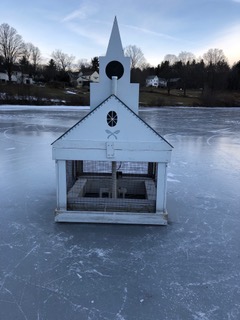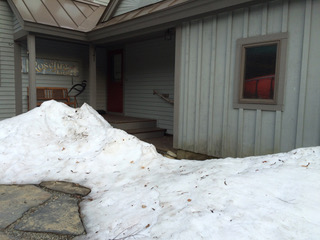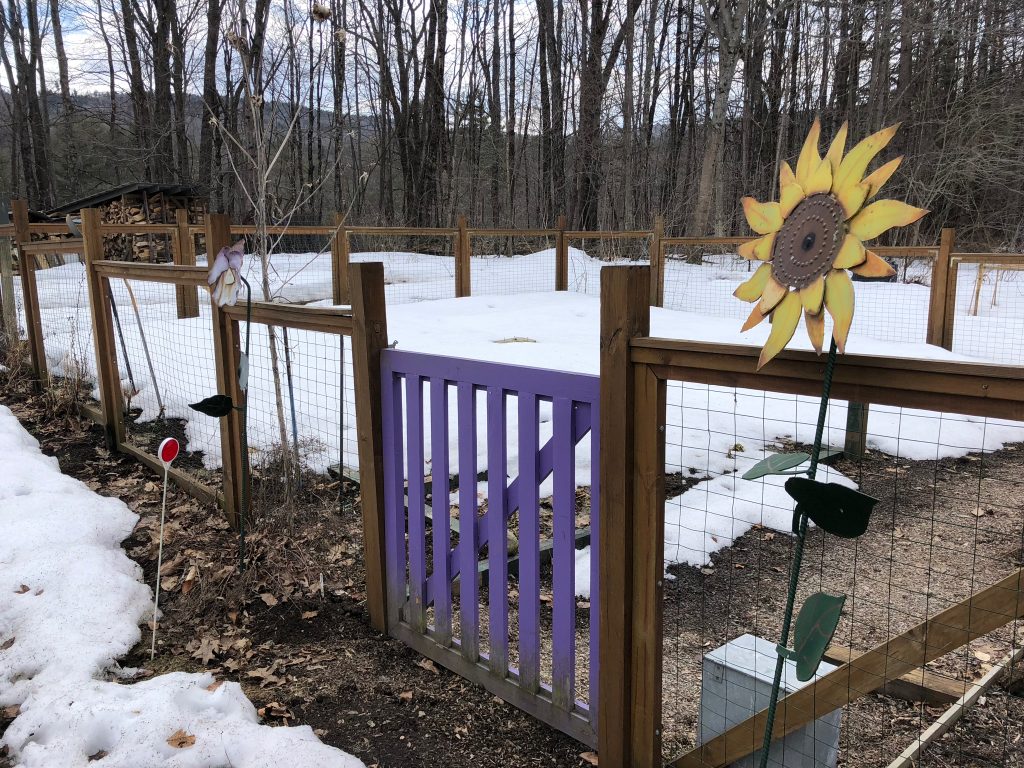
Ice Out is a big deal in northern New England, where we’re often four weeks into spring before the first spears of daffodils emerge from the soil, and five weeks or more before we see a yellow bloom.
Ice Out means the weather really is shifting from early spring (often indistinguishable from winter), to mid-spring, when we don’t have to keep the wood stove going 24/7.
What is Ice Out?
Ice Out is the moment when ice melts from a lake or pond. Betting on Ice Out is a way to pass the time while waiting for this to happen.
I know of at least two places where betting on Ice Out is something of a Big Deal: Joe’s Pond in northern Vermont, and Norway Pond, in southern New Hampshire. These are two places where people buy tickets and guess the day and time that a clock connected to a brick placed out on the ice will fall through. The ticket closest to the actual time the clock stops takes the cash.
How Does It Work?
In Danville, Vermont, a cement block is placed on a wooden pallet in the middle of Joe’s Pond when the water freezes in December. One end of a rope is attached to the block, the other to a Rube Goldberg contraption rigged to stop a clock on shore. When the block falls in the water, the rope stops the clock.
Traditionally, this happens sometime between April fifth and May sixth, and the person with the closest guess wins upwards of five grand.

The folks in Hancock, New Hampshire, run their Ice Out a bit differently. First, their equipment is high tech, and sends data wirelessly to the web during the time that Norway Pond is frozen. Second, Hancock’s Ice Out is a fundraiser for the Meeting House/Vestry Fund of the local Congregational Church. Both these differences help explain why instead of a simple cinder block mechanism, the Norway Pond timer is housed in a model of a church. The rules for Hancock’s Ice Out can be found here.
Ice Out at Rosefire Farm


Taking down the sign. 
We celebrate Ice Out at our house, but it has nothing to do with melting pond water and everything to do with reopening the front door. Ever since we replaced the failing cedar shingles with a standing seam steel roof, we’ve stopped shoveling the front walk.

Not shoveling the walkway was a practical measure as well as a labor saving one. Snow slides off the metal roof with the force of an avalanche. It compacts on landing, making it hard to shovel. Worse, it could and most probably would harm anyone standing in the snow’s path. So we lock the front door, block the front walk, and hang signs directing visitors to walk enter through the back door into the mudroom, where they can shed their winter gear, including wet boots.
For us, Ice Out occurs on the day we remove the last of the ice blocking the path to the front door. This year, it was Sunday, April fourteenth. Last year, it was April thirteenth. You get the idea.
What Ice Out Means

By the time Ice Out liberates our front door, only small patches of snow remain along the edges of the field, and they’re shrinking fast. I can open the gate to the garden again. This week, I’ll harvest parsnips that overwintered in the ground. I’ll shed a layer of fleece, sweep up winter’s sand, and celebrate the ancient stories of liberation and rebirth.

As you know we can totally relate here in AK.
It was such a pleasure to meet you and I’m only sorry that it was for such a sad occasion. Maybe our paths will cross again. Love your writing Deb.
I love this post and the way that you renegades across the pond know how to celebrate the changing of the seasons so much better than we do back in the old country. I’m sure there must some places in the UK where such things are still marked and perhaps it is just my ignorance, but it certainly feels that here we have largely forgotten the old traditions.
So, with that in mind, I though I’d share with you my own version of Ice Out.
It is a very localised custom, in fact it only takes place in our house. It is called Tortoise Out. I inherited the tortoise 14 years ago from my parents, who had inherited him from my aunt. We know that my aunt bought him when my brother was born, so he is approaching 72 years of being in our family. An heirloom.
Each year, he goes into hibernation around the end of October. (I had wanted to say the Autumn equinox, as that sounds more in tune with nature and the seasons – but I did a spot of fact-checking and the equinox is about a month earlier sadly).
Tortoise Out happens usually mid-March to mid-April and I keep records, mainly to check his weight stays at a healthy and safe level.
This year, however, Tortoise Out happened on 20th February, beating his previous early record by 3 days.
Tortoise Out is followed by a period of weeks / months of him living in the kitchen until it is warm enough for him to live outdoors again. This also means that it is a period where the mop and bucket are on permanent standby.
I am therefore looking forward to the period known as Tortoise Out Out!